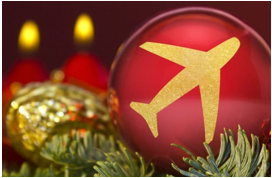
BOSTON – The Transportation Security Administration (TSA) is expecting a busy end of year holiday season at New England airports. The official end-of-the-year holiday travel season is already underway and will continue through Tuesday, January 2. During this period, TSA is projecting higher than usual travel volumes at airports throughout New England leading to reminders to arrive at the airport early and prepared.
The busiest days of the holiday season locally and nationally for air travel are projected to be Thursday, December 21 and Friday, December 22 as well as Thursday, December 28 and Friday, December 29, 2023.
“Our Transportation Security Officers throughout New England did a fantastic job meeting travel volume demand during the Thanksgiving holiday season.” said Bob Allison, TSA Federal Security Director for Massachusetts. “They kept airport screening lanes efficiently moving to ensure more nearly 1-million passengers arrived at their destinations safely, and I expect more of the same for the end-of-year holidays.”
In order to keep screening lanes moving quickly throughout the holiday season, travelers can help by following these tips:
Tip #1: Get to the airport early
Travelers should arrive a minimum of 90 minutes to two hours before their scheduled domestic flights and three hours before scheduled international flights.
If you find yourself waiting in a security checkpoint lane, use that time to your advantage. That’s the ideal time to remove items from your pockets and place them into a carry-on bag. It’s also the time to get out your ID and boarding pass so you’re not fumbling in your wallet for your ID when you step up to the TSA travel document checking podium.
Tip #2: Know before you go
Travelers need to know what can and cannot go in their carry-on bag, from firearms to oversize liquids. Passengers will spend more time in the security checkpoint if their carry-on items trigger an alarm because it results in TSA’s need to resolve the alarm by opening the carry-on bag to determine what triggered the alarm.
The most common item that travelers bring to the checkpoint that is not permitted through the screening process are liquids, gels and aerosols that are larger than the acceptable limit. Each passenger may carry liquids, gels and aerosols that are 3.4 ounces (100 ml) or smaller through a checkpoint as long as those items fit into a one quart-sized, resealable bag. This is known as the 3-1-1 bag. Common travel items that must comply with the liquids rule include toothpaste, shampoo, conditioner, sun block, body spray, mouthwash and lotions. Containers of liquids, gels and aerosols that are larger can be transported in checked baggage. This includes snow globes, which are popular at this time of the year.
TSA officers also are seeing travelers arrive at the checkpoint with bottles of water, juice, energy drinks, coffee and soda. TSA officers will give travelers the choice to exit the security checkpoint to drink their beverages in the terminal or allow the officer to dispose of it. Travelers may bring empty containers such as a water bottle or insulated container through checkpoints and fill them after passing through the checkpoint.
Nationally TSA is on pace to set a record for the most firearms caught at checkpoints in a year. “In New England we’ve detected a record number 52 firearms at security checkpoints,” Allison said. “We’re hoping to see fewer travelers bringing guns to checkpoints. We need all responsible gun owners to clear their carry-on bag of any weapons, ammunition and any other dangerous items before they come to the airport. Bringing a firearm to the checkpoint could result in that traveler missing their flight. It also disrupts and severely delays the screening process for everyone in line.”
Tip #3: Use TSA’s tools for your resources
Unsure if an item should be packed in a carry-on bag, checked bag, either or neither? Download the free myTSA app, which has a handy “What can I bring?” feature that allows you to type in the item to find out if it can fly. Or ask on Twitter or Facebook Messenger at @AskTSA. Travelers may send a question by texting “Travel” to AskTSA (275-872).
TSA Cares is a helpline that provides travelers with disabilities, medical conditions and other special circumstances additional assistance during the security screening process. Call 72 hours prior to traveling at 855-787-2227 with questions about screening policies, procedures and what to expect at the security checkpoint. Or email TSA Cares. TSA Cares is available 8 a.m. to 11 p.m. ET on weekdays and from 9 a.m. to 8 p.m. ET on weekends and holidays.
Use of gift boxes and gift bags are recommended for traveling with gifts.
Tip #4: Traveling with gifts
This is the time of year that passengers travel with gifts. TSA recommends packing gifts in gift bags or boxes instead of wrapping them because if a gift triggers an alarm, it will need to be opened to resolve the alarm. Wrapped presents that trigger an alarm will need the gift wrap removed, but if the gift is in a bag or a box, it is much easier for TSA to look at the item to resolve the alarm.
Tip #5: Traveling with food
Individuals often like to travel with food items during the holiday season. Foods may be transported on flights. Solid food items like fruitcake, candy canes and chocolates are solids and may be transported in a carry-on bag. However, liquids and spreadable foods such as egg nog, wine, champagne, maple syrup and preserves are not solid and should be packed in checked bags. Here’s a helpful tip: If you can spill it, spread it, spray it, pump it or pour it and it is larger than 3.4 ounces, it needs to be packed in a checked bag.
For more information on traveling safely during the holiday season, please visit www.tsa.gov.
